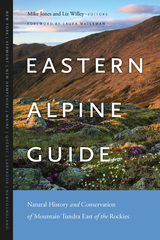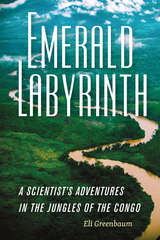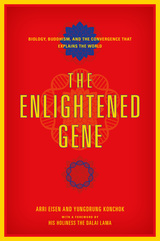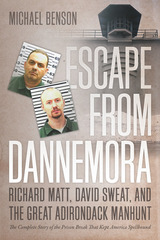247 scholarly books by University Press of New England and 5
start with E
247 scholarly books by University Press of New England and 5
247 scholarly books by University Press of New England
5 start with E start with E
5 start with E start with E

Eastern Alpine Guide
Natural History and Conservation of Mountain Tundra East of the Rockies
Edited by Mike Jones and Liz Willey
University Press of New England, 2018
This unique book celebrates and documents the incredible and colorful biodiversity of the mountain landscapes of eastern North America, covering all of the major alpine ecosystems in New England, New York, Québec, Newfoundland, and Labrador. Twenty scientists, explorers, naturalists, and land managers from the United States and Canada have collaborated to create this definitive and beautiful account of the flora and fauna of the eastern alpine tundra.
[more]

Emerald Labyrinth
A Scientist's Adventures in the Jungles of the Congo
Eli Greenbaum
University Press of New England, 2017
Emerald Labyrinth is a scientist and adventurer’s chronicle of years exploring the rainforests of sub-Saharan Africa. The richly varied habitats of the Democratic Republic of the Congo offer a wealth of animal, plant, chemical, and medical discoveries. But the country also has a deeply troubled colonial past and a complicated political present. Author Eli Greenbaum is a leading expert in sub-Saharan herpetology—snakes, lizards, and frogs—who brings a sense of wonder to the question of how science works in the twenty-first century. Along the way he comes face to face with spitting cobras, silverback mountain gorillas, wild elephants, and the teenaged armies of AK-47-toting fighters engaged in the continent’s longest-running war. As a bellwether of the climate and biodiversity crises now facing the planet, the Congo holds the key to our planet’s future. Writing in the tradition of books like The Lost City of Z, Greenbaum seeks out the creatures struggling to survive in a war-torn, environmentally threatened country. Emerald Labyrinth is an extraordinary book about the enormous challenges and hard-won satisfactions of doing science in one of the least known, least hospitable places on earth.
[more]

The Enlightened Gene
Biology, Buddhism, and the Convergence that Explains the World
Arri Eisen and Yungdrung Konchok
University Press of New England, 2017
Eight years ago, in an unprecedented intellectual endeavor, the Dalai Lama invited Emory University to integrate modern science into the education of the thousands of Tibetan Buddhist monks and nuns in exile in India. This project, the Emory Tibet Science Initiative, became the first major change in the monastic curriculum in six centuries. Eight years in, the results are transformative. The singular backdrop of teaching science to Tibetan Buddhist monks and nuns offered provocative insights into how science and religion can work together to enrich each other, as well as to shed light on life and what it means to be a thinking, biological human. In The Enlightened Gene, Emory University Professor Dr. Arri Eisen, together with monk Geshe Yungdrung Konchok explore the striking ways in which the integration of Buddhism with cutting-edge discoveries in the biological sciences can change our understanding of life and how we live it. What this book discovers along the way will fundamentally change the way you think. Are humans inherently good? Where does compassion come from? Is death essential for life? Is experience inherited? These questions have occupied philosophers, religious thinkers and scientists since the dawn of civilization, but in today’s political discourse, much of the dialogue surrounding them and larger issues—such as climate change, abortion, genetically modified organisms, and evolution—are often framed as a dichotomy of science versus spirituality. Strikingly, many of new biological discoveries—such as the millions of microbes that we now know live together as part of each of us, the connections between those microbes and our immune systems, the nature of our genomes and how they respond to the environment, and how this response might be passed to future generations—can actually be read as moving science closer to spiritual concepts, rather than further away. The Enlightened Gene opens up and lays a foundation for serious conversations, integrating science and spirit in tackling life’s big questions. Each chapter integrates Buddhism and biology and uses striking examples of how doing so changes our understanding of life and how we lead it.
[more]

Escape from Dannemora
Richard Matt, David Sweat, and the Great Adirondack Manhunt
Michael Benson
University Press of New England, 2017
It was one of the biggest crime stories of the decade—two deadly killers, desperate and on the run. After months of planning, Ricky Matt and David Sweat cut, chopped, coerced, and connived their way out of a maximum-security prison in the wilderness of upstate New York and managed to elude police for three weeks, sending the region into lockdown and keeping the entire country on edge. The media called it “a bold escape for the ages,” and veteran true-crime writer Michael Benson leads us along the story’s every wild path to dig out a tale of adventure, psychology, sex, and brutality. Escape from Dannemora examines the strange case of Joyce Mitchell, the long-time prison employee who had a sexual relationship with at least one of the killers, and who smuggled them tools and aided in the escape, while they cooked up a plan to kill her husband. In the end, Benson looks closely at conditions at the Clinton Correctional Facility in Dannemora, NY, a crumbling Gothic pile now under investigation for charges of drug trafficking and brutality.
[more]

Eternally Eve
Images of Eve in the Hebrew Bible, Midrash, and Modern Jewish Poetry
Anne Lapidus Lerner
University Press of New England, 2007
The biblical accounts of Eve's life are central to Western culture, occupying a privileged place in our literature and art, culture, and society. For both Judaism and Christianity, these stories involving Eve have for centuries been entangled with the religious and social construction of gender. The ambiguous biblical record of her life from the two versions of her creation, through her encounter with the forbidden fruit, to her expulsion from Eden, and followed by the tantalizing glimpses of her life in the real world has served through the ages as a mirror of commonly held views about women. For Jewish readers, Eve's role as metonym -- signifying womanhood, or Jewish womanhood, as a whole -- is of prime importance. By tracing the imagined character of Eve from ancient times to the present, Eternally Eve opens a window on the transmission and persistence of cultural and social values. Eternally Eve takes as its subject the many ways these stories can be read, interpreting the biblical narratives as well as their iteration by rabbinic midrashists and modern poets. Anne Lapidus Lerner argues that we must set aside, or at least rethink, a series of assumptions about Eve that have been dominant in Jewish thought for centuries and instead return to the original texts to rediscover meanings implicit in them. Using modern poetry about Eve as a touchstone for reinterpreting older texts, Lerner discovers that Genesis is often more open to contemporary values than are later rabbinic texts. Linking sacred texts to works of the classical and modern imagination, Lerner restores to her sources meanings suppressed or neglected over many years and demonstrates their power to speak today.
[more]
READERS
Browse our collection.
PUBLISHERS
See BiblioVault's publisher services.
STUDENT SERVICES
Files for college accessibility offices.
UChicago Accessibility Resources
home | accessibility | search | about | contact us
BiblioVault ® 2001 - 2024
The University of Chicago Press









